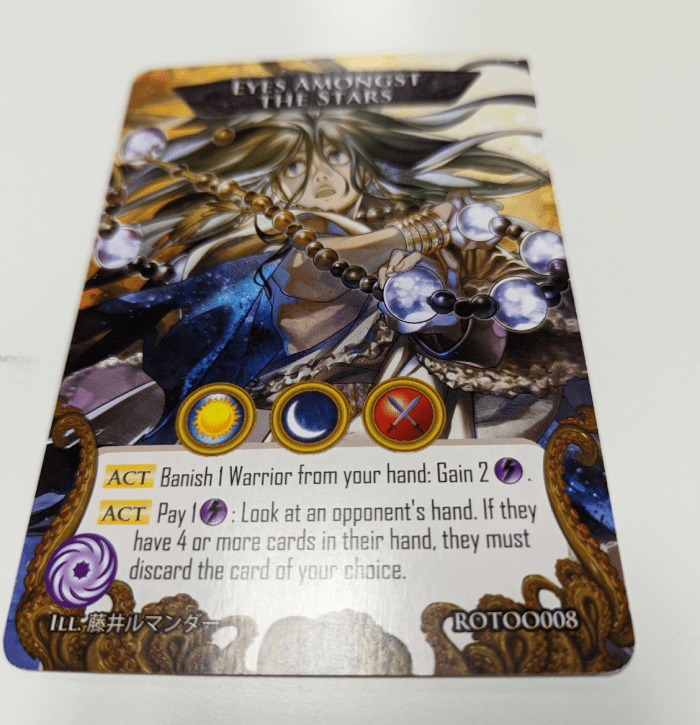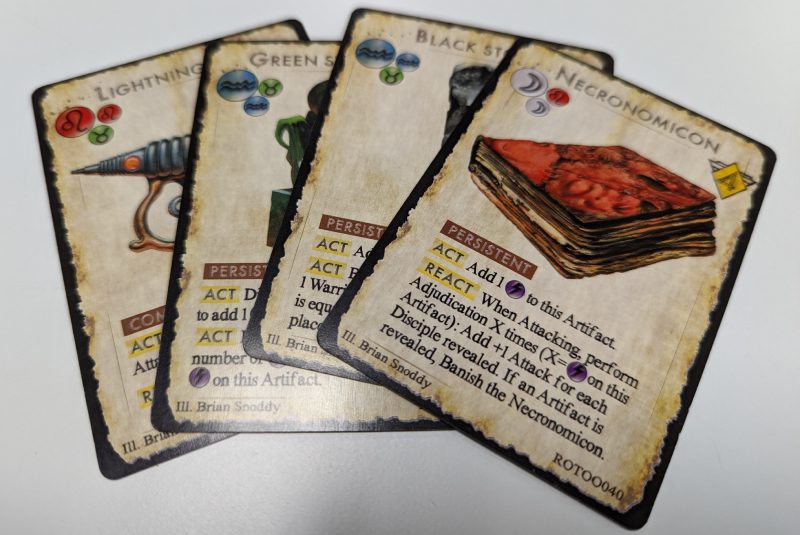Disclosure: Meeple Mountain received a free copy of this product in exchange for an honest, unbiased review. This review is not intended to be an endorsement.
Since Dominion graced us with its presence over ten years ago, every board game company wants an expandable deckbuilder to cash in on this profitable genre. If we stacked all the deckbuilders and expansions to make a tower, it would be one of the tallest structures in the world, although it would still look small compared to a stack of unsold copies of Seafall.
Kamigami Battles: Rise of the Old Ones is another deckbuilder box to add to that tower. It’s about Gods who, for whatever reason, don’t like each other and now want to smack their rivals out of existence. There is no smiting here as they do the battles through card games. In other words, a sexy Yugioh.
Sexy is the right word here, considering this series’ history and lewd art direction. Kamigami Battles: Rise of the Old Ones, now referred to as Kamigami Battles, is the third game in a series.
A dirty history
Originally released in 2012 under the name Kanzume Goddess, the game was notorious for its awkward tin can packaging and, umm…pinup artwork? That’s the best way to describe it.
In 2018, Japanime Games re-released the game in a new package called Kamigami Battles: Battle of the Nine Realms. Despite barely getting media attention and being the subject of ridicule on social media because of its raunchy art, the game was a hit for them. Later that same year, they released another standalone version with more expansions and accessories to fatten their wallets. Not bad for a game that stirred some controversy.
Now we are in 2022 with a Cthulhu-themed version because that seems to be the norm nowadays. To be fair, the game is about mythological Gods fighting it out, and Cthulhu mythos is a good fit.
First impressions after understanding its history might lead you to believe this only sold well because of boob art. I can’t buy that theory, considering that looking for such material is a simple Google search away. Surely there had to be something more, right?
Yeah, there is. I will even say that this is one of the better deckbuilders out there, especially when you compare it to other duel deckbuilder games like Shards of Infinity or Star Realms.
But I think I’m getting ahead of myself here. We should probably talk about the game’s mechanisms and a good start would be the Gods themselves.

Let sleeping Gods lie
Every God has their own set of abilities to play with and starts out with 15 energy. This energy is not only your health, but your currency to use your God’s abilities. You also have a Location card with its own power and 5 energy. The task is simple: Kill the other Gods, or get to 25 energy.
Like the vast majority of deckbuilders, everyone starts with a weak deck and throughout the course of the game, will buy cards to improve their deck. The story has been told so many times that they could make it into a Disney film.
Fortunately, most of the similarities end there. Kamigami Battles borrows so many other mechanisms from other deckbuilders that it can be called fan fiction. This is not a cargo ship full of original ideas. It’s more about how these ideas congregate.
One sign of this is buying cards. Instead of buying a card and parking it in your discard pile, you put it on top of your deck. This means you will get your newly purchased card on your next turn, and you can buy as many as you like.
Even the market itself, called the Hall of Heroes, is subject to these modifications: It’s not a fixed stack system like Dominion or a random row of cards like Ascension. It’s both.

Same differences
There are always six unique stacks of Warrior cards available. Whenever a stack is empty, you draw from the deck. If it matches existing Warriors in the market, add it to the stack, and draw again until you have six unique stacks of Warriors. Fans of Machi Koro 2 will recognize this system.
Artifact cards, which are new to this version, are comparable to Warrior cards in terms of functionality. Their market is parallel to Ascension, where you buy a card and it’s immediately replaced. Finally, there are three stacks of Disciple cards that act as this game’s currency and defense.
Now I could say the differences stop there, but that would be a lie because we still need to talk about playing cards. You play one card at a time, resolving the effects before moving on to the next card. That sounds typical until you realize that most cards have two actions, and you pick one of them to use. There is a lot more reading than the standard deckbuilder.
Another obstacle to deal with when playing cards is chaining them together. You can play as many Discipline cards as you like, but the Warriors and Artifacts? Different story. Both types of cards have a main color and two link colors. For example, if you play a Red card with link colors of Yellow and White, the next Warrior or Artifact card must be Yellow or White. You can play as many Warrior or Artifact cards as long as the colors chain together.
Before anyone raises their hand, yes, I know that they directly stole this from AEG’s Nightfall, only this does it so much better.
Easier than reading the Necronomicon
If there is one thing I can say about Kamigami Battles, it’s easy to learn if you have a familiarity with the deckbuilder genre. The rules are intuitive, with the complexity coming from the cards themselves, not navigating its system.
However, just because I say the game is easy to learn, doesn’t necessarily mean it’s an easy game to become skillful at. Most of the difficulties come from both the God powers and the chaining.
Even at the most casual levels, understanding chaining is crucial. You can’t take the knowledge gained from previous deckbuilders and apply it here. Any attempt to do so will lead to embarrassment far worse than Michael Jordan’s baseball career.
Chaining goes beyond limiting how you play your cards. It demands that you become intimate with your deck and be mindful of your purchases. Unlike other deckbuilders, you simply cannot buy the most expensive card or one that sounds cool. Buying decisions need to be scrutinized, like those of a CEO of a Fortune 500 company.
This doesn’t apply only to you; it applies to your opponent as well. You need to pay attention to what they are buying, since the cards they buy will affect what they want in the future to create their combos. There is a lot more going on than drafting cards.
I would be fine if it was just that throughout the game, but it isn’t. I’ve mentioned the God powers, but I didn’t mention how ridiculous they are.

Killing God like you’re in a JRPG
For instance, Nyarlathotep. Their main ability is paying 1 energy to remove 1 energy from everyone else, making them a ticking time bomb. That sounds nasty until you look at their Reaction. Whenever their energy hits 0, they can banish a Warrior in their hand to go back to 1 energy instead.
Because of these abilities, it forces you to analyze the situation far more than most deckbuilders. You can’t simply buy the most expensive cards because that takes time, time you don’t have. You need to rush down Nyarlathotep quickly before they can amass many warriors to sacrifice for the upcoming war of attrition.
Mind you, that’s only one God. There is Cthulhu, who can ignore chains once per turn, Nodens, who can banish Warriors from discard piles, and Ithaqua, who can banish cards for extra currency to buy more cards. Playing with these powers forces you to come up with new deckbuilding strategies in each game, forcing you to examine the relationship between your God and your opponent’s God. These powers make the battles feel like David vs Goliath, with everyone thinking they are David.
There is a psychological aspect as well. You don’t play all of your cards at once. You play a card one at a time, resolving their effects. That includes attacks, meaning if I play a card with Attack 2, you must decide at that very moment if you want to respond to it. Do I have a follow-up? Am I trying to bait your cards? That’s for you to figure out.
All this is coming from the perception of a 1 on 1 duel, so I need to address the player scaling. The box says it can play up to six players, and I don’t know why they think that is the case.
Crowd Surfing
I would never touch this game with five or six players because the downtime would be way too much for my patience. Three players work well since you need to have some metagame diplomacy on top of your deckbuilding skills. Four players can work, assuming you have players that don’t take forever to decide. Several of my four-player games lasted close to two hours due to slow players.
There is also a team play variant and I recommend not to touch it. It doesn’t work well, takes too long, and is far more defensive than necessary.
Players who are new to deckbuilders might be overwhelmed by the amount of text here. Most deckbuilders tend to stick to one ability on a card, whereas here a card will often have two choices. I don’t find it difficult to understand, but I can’t ignore the hurdle either.
As for some of you who are a bit more competitive, the balance between the cards and Gods is all over the map. Some Gods work well in all situations, while a few are situational, and some that I question. Don’t expect something as balanced and airtight as Eternal: Chronicles of the Throne.
The wording on some cards could’ve been much better as sometimes there is inconsistency or room for interpretation. The rulebook is doing a fabulous job explaining the game, so it’s odd to see this.

Less fat in this cheesecake
I have to mention the artwork since the Kamigami Battles series’ key feature is the fantastic art. This is still true for this latest edition, although far less lewd. Men have more of a presence here, and there is less cheesecake. I said less and not outright eliminated, as some cards have a bust size that goes beyond the letter D. Let’s say I don’t feel like I would be on several watch lists after showing this game in public.
I wasn’t expecting Kamigami Battles to take me in this direction. As a deckbuilder connoisseur, I find most games in this genre to be formulaic and boring. Kamigami Battles will not win any awards for originality, yet it somehow combines all these mechanisms from other games into a marriage that somehow works.
There are some things that aren’t perfect, such as the wording on the cards or the balance between the Gods. It’s a far better attempt than most games I see in this genre that somehow conjure a community behind them. If you can get past the suggestive artwork that would make Frank Frazetta take notes, you’ll find something special in this one.












Add Comment